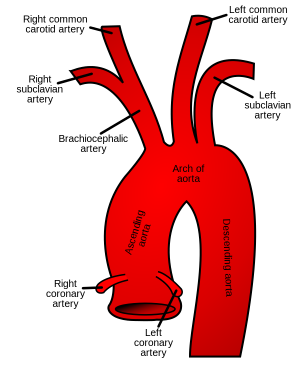Common Carotid Artery
Original Editor - Asma Alshehri
Top Contributors - Asma Alshehri, Kim Jackson, Adam Vallely Farrell, Lucinda hampton and Evan Thomas
Description[edit | edit source]
The Common Carotid artery is a large elastic artery which provides the main blood supply to the head and neck. There is one common carotid artery on either sides of the body (Right and Left carotid arteries).[2] They supply the head and neck with oxygenated blood and they divide in the neck to form the external and internal carotid arteries.
Although the right and left carotid arteries follow the same course through the neck, their origins differ, where the left common carotid arises directly from the branch of the aortic arch whereas on the right, the origin is from the brach of the brachiocephalic trunk.[3]
Course:[edit | edit source]
Whilst these arteries originate from different arteries, they follow symmetrical courses. Posterior to sternoclavicular joint and lateral to thyroid and trachea. [3] The arteries split into the external and internal carotid arteries at the upper border of the thyroid cartilage, at around the level of the fourth cervical vertebra.
Branches and divisions:[edit | edit source]
Each carotid artery branches into two divisions:
- The internal carotid artery supplies blood to the brain
- The external carotid artery supplies blood to the face and neck.[4]
Note:
(The left common carotid artery can be thought of as having two distinct parts: thoracic and cervical while the right common carotid artery has only a cervical portion since it arises cranially)[3]
Supply:[edit | edit source]
It mainly gives supply to the head and neck.
Clinical relevance:[edit | edit source]
The common carotid artery is frequently used in measuring a persons pulse, especially in those patients who are in shock and lack a detectable pulse in the more peripheral arteries of the body. The pulse is taken by palpating the artery just deep to the anterior border of the sternocleidomastoid muscle at the level of the superior border of the thyroid cartilage. The presence of a carotid pulse has been estimated to indicate a systolic blood pressure of more than 40 mmHg, as given by the 50% percentile.
Carotid stenosis:
It is a narrowing of the carotid arteries caused by a buildup plaque (atherosclerosis) inside the artery wall that reduces blood flow to the brain which my cause a stroke.
Plaque is a sticky substance made of fat, cholesterol, calcium and other fibrous material. [5]
Carotid Sinus Hypersensitivity:
Carotid sinus hypersensitivity is an increased response to carotid sinus stimulation, which can occur with advanced age, coronary artery disease or hypertension. External pressure on the carotid sinus can cause bradycardia and hypotension, which can lead to dizziness or syncope. Therefore, palpation of the carotid pulse is not recommended in patients with this condition.[2]
Carotid artery aneurysm:
A weak area of the carotid artery allows part of the artery to bulge out like a balloon with each heartbeat. Aneurysms pose a risk for breaking, which could result in stroke or severe bleeding, or hemorrhage.[4]
Carotid artery vasculitis:
Inflammation of the carotid artery, due to an autoimmune condition or an infection.[4]
References:[edit | edit source]
- ↑ Anatomy of the Human Body Gray's Anatomy
- ↑ 2.0 2.1 Common carotid artery, https://www.kenhub.com/en/library/anatomy/common-carotid-artery (accessed 29 may 2017)
- ↑ 3.0 3.1 3.2 Common carotid artery, https://radiopaedia.org/articles/common-carotid-artery-2 (accessed 30 may 2017)
- ↑ 4.0 4.1 4.2 Picture of the carotid artery, http://www.webmd.com/heart/picture-of-the-carotid-artery#1 (accessed 31 may 2017)
- ↑ Carotid stenosis, https://www.mayfieldclinic.com/PE-CarotidStenosis.htm (accessed 1 June 2017)







